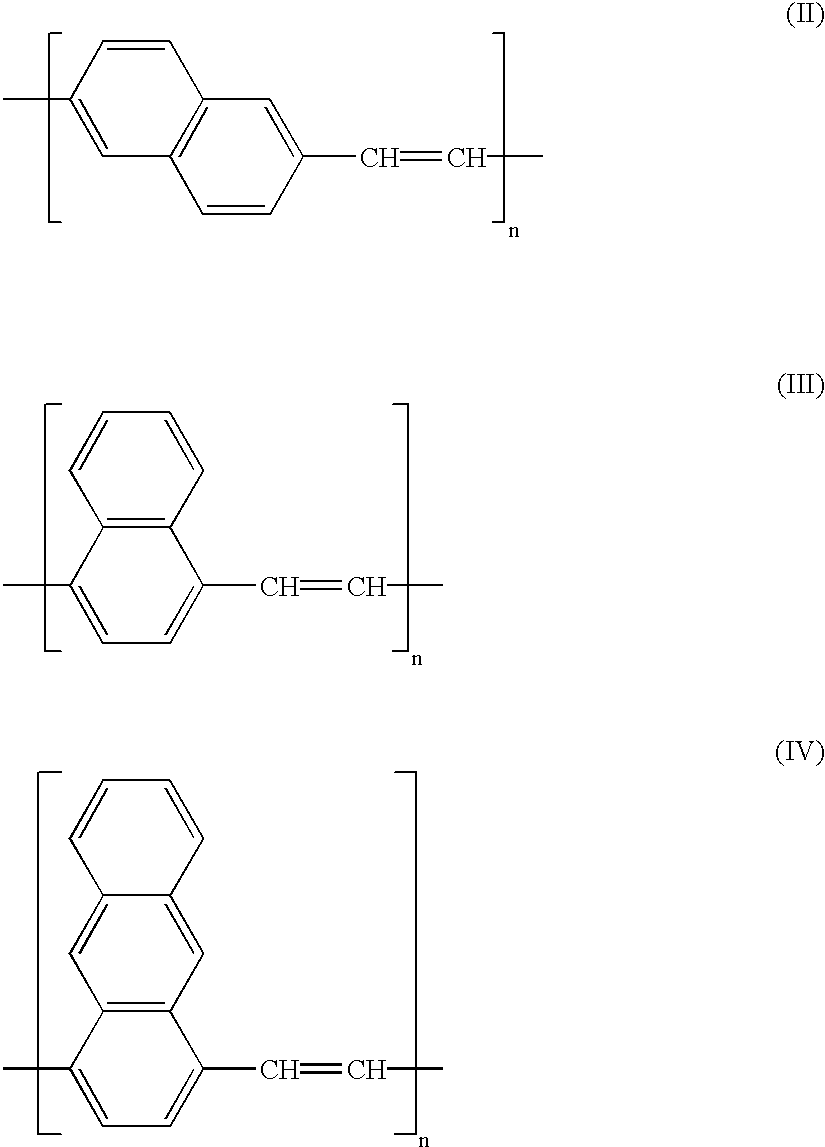Organic electroluminescent device
an electroluminescent device and organic technology, applied in the direction of discharge tube luminescnet screen, thermoelectric device, discharge tube/lamp details, etc., can solve the problems of significant acceleration of the degradation of organic thin films, sensitivity to electrodes, and the organic materials of which the organic layers are formed. , to achieve the effect of long life, high efficiency and low cos
- Summary
- Abstract
- Description
- Claims
- Application Information
AI Technical Summary
Benefits of technology
Problems solved by technology
Method used
Image
Examples
example 1
A substrate of (7059) glass by Corning Glass Works was scrubbed using a neutral detergent.
By RF magnetron sputtering from a target of ITO oxide, a hole injecting electrode layer of ITO having a thickness of 200 nm was formed on the substrate at a temperature of 250.degree. C.
After its ITO electrode-bearing surface was cleaned with UV / 03, the substrate was secured by a holder in a sputtering chamber, which was evacuated to a vacuum of 1.times.10.sup.-4 Pa or lower.
Using a target of SiO.sub.2, an inorganic insulative hole injecting layer was deposited to a thickness of 2 nm. The sputtering gas used was a mixture of 100 sccm of argon and 10 sccm of oxygen (O.sub.2). Sputtering conditions included a substrate temperature of 25.degree. C., a deposition rate of 1 nm / min, an operating pressure of 0.5 Pa, and an input power of 5 W / cm.sup.2 The hole injecting layer as deposited had a composition of SiO.sub.1.7.
A methanol solution of a PPV precursor having a concentration of 1 g of polymer pe...
example 2
In Example 1, the PPV film was formed directly on the ITO electrode without interleaving the inorganic insulative hole injecting layer.
With the vacuum kept, the substrate was transferred to a sputtering chamber. Using a mixture of potassium oxide (K.sub.2 O, electron affinity 2.0 eV) and 5 mol % of silicon oxide (SiO.sub.2) as the target, an inorganic electron injecting layer was deposited to a thickness of 1 nm. Sputtering conditions included a substrate temperature of 25.degree. C., a 1:1 mixture of sputtering gas Ar and oxygen (O.sub.2), a deposition rate of 1 nm / min, an operating pressure of 0.5 Pa, and an input power of 5 W / cm.sup.2.
Thereafter, as in Example 1, the electron injecting layer and auxiliary electrode were formed, obtaining an organic EL device.
The organic EL device was examined as in Example 1, finding equivalent results to Example 1.
example 3
An organic EL device was fabricated as in Example 1 except that the inorganic insulative electron injecting layer of Example 2 was formed after the formation of the PPV film.
The organic EL device was examined as in Example 1, finding equivalent results to Example 1.
PUM
 Login to View More
Login to View More Abstract
Description
Claims
Application Information
 Login to View More
Login to View More - R&D
- Intellectual Property
- Life Sciences
- Materials
- Tech Scout
- Unparalleled Data Quality
- Higher Quality Content
- 60% Fewer Hallucinations
Browse by: Latest US Patents, China's latest patents, Technical Efficacy Thesaurus, Application Domain, Technology Topic, Popular Technical Reports.
© 2025 PatSnap. All rights reserved.Legal|Privacy policy|Modern Slavery Act Transparency Statement|Sitemap|About US| Contact US: help@patsnap.com



